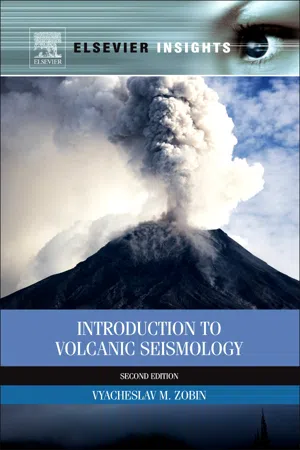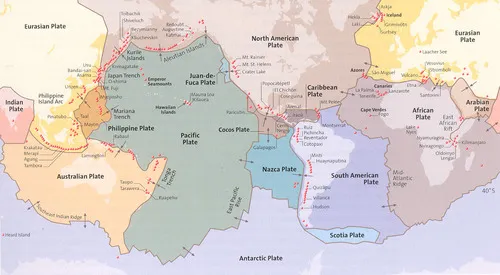
- 474 pages
- English
- ePUB (mobile friendly)
- Available on iOS & Android
eBook - ePub
Introduction to Volcanic Seismology
About this book
Volcanic seismology represents the main, and often the only, tool to forecast volcanic eruptions and to monitor the eruption process. This book describes the main types of seismic signals at volcanoes, their nature and spatial and temporal distributions at different stages of eruptive activity. Following from the success of the first edition, published in 2003, the second edition consists of 19 chapters including significant revision and five new chapters. Organized into four sections, the book begins with an introduction to the history and topic of volcanic seismology, discussing the theoretical and experimental models that were developed for the study of the origin of volcanic earthquakes. The second section is devoted to the study of volcano-tectonic earthquakes, giving the theoretical basis for their occurrence and swarms as well as case stories of volcano-tectonic activity associated with the eruptions at basaltic, andesitic, and dacitic volcanoes. There were 40 cases of volcanic eruptions at 20 volcanoes that occurred all over the world from 1910 to 2005, which are discussed. General regularities of volcano-tectonic earthquake swarms, their participation in the eruptive process, their source properties, and the hazard of strong volcano-tectonic earthquakes are also described. The third section describes the theoretical basis for the occurrence of eruption earthquakes together with the description of volcanic tremor, the seismic signals associated with pyroclastic flows, rockfalls and lahars, and volcanic explosions, long-period and very-long-period seismic signals at volcanoes, micro-earthquake swarms, and acoustic events. The final section discuss the mitigation of volcanic hazard and include the methodology of seismic monitoring of volcanic activity, the examples of forecasting of volcanic eruptions by seismic methods, and the description of seismic activity in the regions of dormant volcanoes.
This book will be essential for students and practitioners of volcanic seismology to understand the essential elements of volcanic eruptions.
- Provides a comprehensive overview of seismic signals at different stages of volcano eruption.
- Discusses dozens of case histories from around the world to provide real-world applications.
- Illustrations accompany detailed descriptions of volcano eruptions alongside the theories involved.
Frequently asked questions
Yes, you can cancel anytime from the Subscription tab in your account settings on the Perlego website. Your subscription will stay active until the end of your current billing period. Learn how to cancel your subscription.
No, books cannot be downloaded as external files, such as PDFs, for use outside of Perlego. However, you can download books within the Perlego app for offline reading on mobile or tablet. Learn more here.
Perlego offers two plans: Essential and Complete
- Essential is ideal for learners and professionals who enjoy exploring a wide range of subjects. Access the Essential Library with 800,000+ trusted titles and best-sellers across business, personal growth, and the humanities. Includes unlimited reading time and Standard Read Aloud voice.
- Complete: Perfect for advanced learners and researchers needing full, unrestricted access. Unlock 1.4M+ books across hundreds of subjects, including academic and specialized titles. The Complete Plan also includes advanced features like Premium Read Aloud and Research Assistant.
We are an online textbook subscription service, where you can get access to an entire online library for less than the price of a single book per month. With over 1 million books across 1000+ topics, we’ve got you covered! Learn more here.
Look out for the read-aloud symbol on your next book to see if you can listen to it. The read-aloud tool reads text aloud for you, highlighting the text as it is being read. You can pause it, speed it up and slow it down. Learn more here.
Yes! You can use the Perlego app on both iOS or Android devices to read anytime, anywhere — even offline. Perfect for commutes or when you’re on the go.
Please note we cannot support devices running on iOS 13 and Android 7 or earlier. Learn more about using the app.
Please note we cannot support devices running on iOS 13 and Android 7 or earlier. Learn more about using the app.
Yes, you can access Introduction to Volcanic Seismology by Vyacheslav M Zobin in PDF and/or ePUB format, as well as other popular books in Ciencias físicas & Sismología y vulcanismo. We have over one million books available in our catalogue for you to explore.
Information
1. Introduction
The subject of volcanic seismology is not only the most beautiful and spectacular, but also the most difficult to study of all the subjects seismologists have encountered on Earth. This is because seismic sources in volcanoes involve dynamic motion of gas, fluid and solid, and propagation paths in volcanoes are usually extremely heterogeneous, anisotropic, and absorptive, with irregular topographies and interfaces including cracks of all scales and orientations. Thus, volcanic seismology is the most challenging to seismologists requiring ingenuity in designing experiments and interpreting observations.
Keiiti Aki, 1982. From the Preface to the Collection of Papers “Volcanic Seismology,” IAVCEI Proceedings in Volcanology, Vol. 3, Springer-Verlag, Berlin.
This is an introduction presenting the subject of volcanic seismology, the terms used in this book, and acknowledgments of the persons and institutions supporting the preparation of this book.
Keywords
Volcanic seismology; volcanology; seismology; tectonics
Volcanic seismology is a science about seismic signals originating from volcanoes and associated with volcanic activity. The study of the origin of these signals, their spatial–temporal distributions, their relationships with volcanic processes, and using them as an instrument to investigate the volcano deep structure and to predict a volcanic eruption together create the subject of volcanic seismology.
1.1. Terms and Definitions
The subject of Volcanic Seismology lies in the interaction between volcanic and seismo-tectonic processes. Therefore, it is necessary to define the main terms of volcanology, tectonics, and seismology at the very beginning of the book.
1.1.1. Volcanic Terms
A volcano is a vent or chimney, which connects a reservoir of molten matter known as magma, in the depths of the crust of the Earth, with the surface of the Earth. The material ejected through the vent frequently accumulates around the opening, building up a volcanic edifice. The material ejected consists of liquid lava and broken fragments of partially or completely solidified rock (pyroclastic debris), as well as great quantities of gases. The gases are the motivating force and the most important factor in volcanic action (Bullard, 1963).
Figure 1.1 shows the main elements of a volcano. A volcanic cone is the result of the accumulation of ejected material around the vent. A crater is the surface connection of the volcanic conduit through which the ejected material reaches the surface. The crater may be situated on the summit of the cone (summit crater) or within the flank cone, situated on a slope of the central volcanic cone (flank crater). An enormous crater representing a large depression in the truncated summit of volcano is called a caldera.
 |
| Figure 1.1 The main elements of volcanic edifice. |
Beneath a volcano, we have the magma feeding system of the volcano that consists of a deep magma reservoir, or chamber that is a reservoir of magma in the shallow part of lithosphere from which volcanic material is derived; an intermediate magma storage, a place between the magma chamber and the Earth’s surface, where magma may be collected before an eruption; and the feeding conduit, connecting the magma collectors with the surface. The surface appearance of magma is called lava (Bullard, 1963). Volcanoes are widely distributed on the surface of the Earth and on the ocean floor (Figure 1.2). Volcanic belts go along subduction zones as well as along oceanic ridges. Simkin and Siebert (1994) have noted more than 1,300 active volcanoes with more than 5,500 dated eruptions.
 |
| Figure 1.2 Major lithospheric plates and global distribution of some active and dormant volcanoes. Courtesy of U.S.G.S. |
A volcanic eruption is a process of material transport from the Earth’s depths to the surface. Figure 1.3, Figure 1.4 and Figure 1.5 show the typical surface manifestation of volcanic features during the activity of basaltic, andesitic, and dacitic volcanoes. According to their origin within the volcanic edifice, the volcanic eruptions may be of central (or summit) type with an eruption of the summit crater, flank (or lateral) type, with an eruption of the flank crater, or fissure type, when the eruption takes place from an elongated fissure, rather than from a central vent.
 |
| Figure 1.3 Surface manifestation of volcanic features during the activity of basaltic volcanoes. (A) The 1975 fissure eruption of New Tolbachik volcanoes, Kamchatka. Eruption from the new cone and its lava flow. (B) Lava fountain and spatter cone on Kilauea Volcano, Hawaii. (C) The November 1989 lava flow on Etna volcano. (A) Photograph by V. Zobin. (B) Photograph by J.D. Griggs; courtesy of U.S.G.S. (C) Photograph by A. Amantia; courtesy of INGV Catania. |
 |
| Figure 1.4 Surface manifestation of volcanic features during the activity of andesitic volcanoes. (A) Block lava flow moving down the flank. Bezymianny volcano, Kamchatka. (B) Lava dome in the crater of Volcán de Colima. (C) Explosion at Kizimen volcano, Kamchatka. (A) (A) Photograph by P. Izbekov; courtesy of Alaska Volcano Observatory. (B) Photograph by M. Bretón; courtesy of Colima Volcano Observatory. (C) Photograph by E. Vlasov; courtesy of the Institute of Volcanology and Seismology. |
 |
| Figure 1.5 Surface manifestation of volcanic features during the activity of dacitic volcanoes. (A) Lateral lava dome Showa Shinzan (Usu volcano, Hokkaido). (B) Surface deformation caused by the subsurface moving of dacitic lava. The 2000 lateral eruption of Usu volcano, Hokkaido. (C) Explosive activity at Karymsky volcano, Kamchatka. Photographs by V. Zobin. |
Magnitude of eruption is described by Volcanic Explosivity Index (VEI) that combines the total volume of explosive products, the eruptive cloud height, descriptive terms, eruption type, duration, and so forth, and have the grades from 0 to 8 (Newhall and Self, 1982). Newhall and Self (1982) proposed the range of VEI for five main types of volcanic eruptions: Hawaiian (VEI 0–1); Strombolian (VEI 1–2); Vulcanian (VEI 2–4); Plinian (VEI 4–8); and Ultra-Plinian (VEI 5–8). The first two types of eruptions, Hawaiian and Strombolian, are common for ...
Table of contents
- Cover image
- Table of Contents
- Front-matter
- Copyright
- Preface to the Second Edition
- Preface to the First Edition
- 1. Introduction
- 2. Seismicity at Volcanoes
- 3. Fundamentals of Volcanic Seismology
- 4. Origin of Volcano-Tectonic Earthquakes
- 5. Volcano-Tectonic Earthquakes at Basaltic Volcanoes
- 6. Volcano-Tectonic Earthquakes at Andesitic Volcanoes
- 7. Volcano-Tectonic Earthquakes at Dacitic Volcanoes
- 8. General Properties of Volcano-Tectonic Earthquake Swarms
- 9. Source Properties of Volcano-Tectonic Earthquakes
- 10. Significant Volcano-Tectonic Earthquakes and Their Role in Volcanic Processes
- 11. Origin of Eruption Earthquakes
- 12. Volcanic Tremor
- 13. Seismic Signals Associated with Pyroclastic Flows, Rockfalls, and Lahars
- 14. Seismic Signals Associated with Volcanic Explosions
- 15. Long-Period and Very Long-Period Seismic Signals at Volcanoes
- 16. Swarms of Microearthquakes Associated with Effusive and Explosive Activity at Volcanoes
- 17. Acoustic Waves Generated by Volcanic Eruptions
- 18. Seismic Monitoring of Volcanic Activity and Forecasting of Volcanic Eruptions
- 19. Seismic Activity at Dormant Volcanic Structures
- References